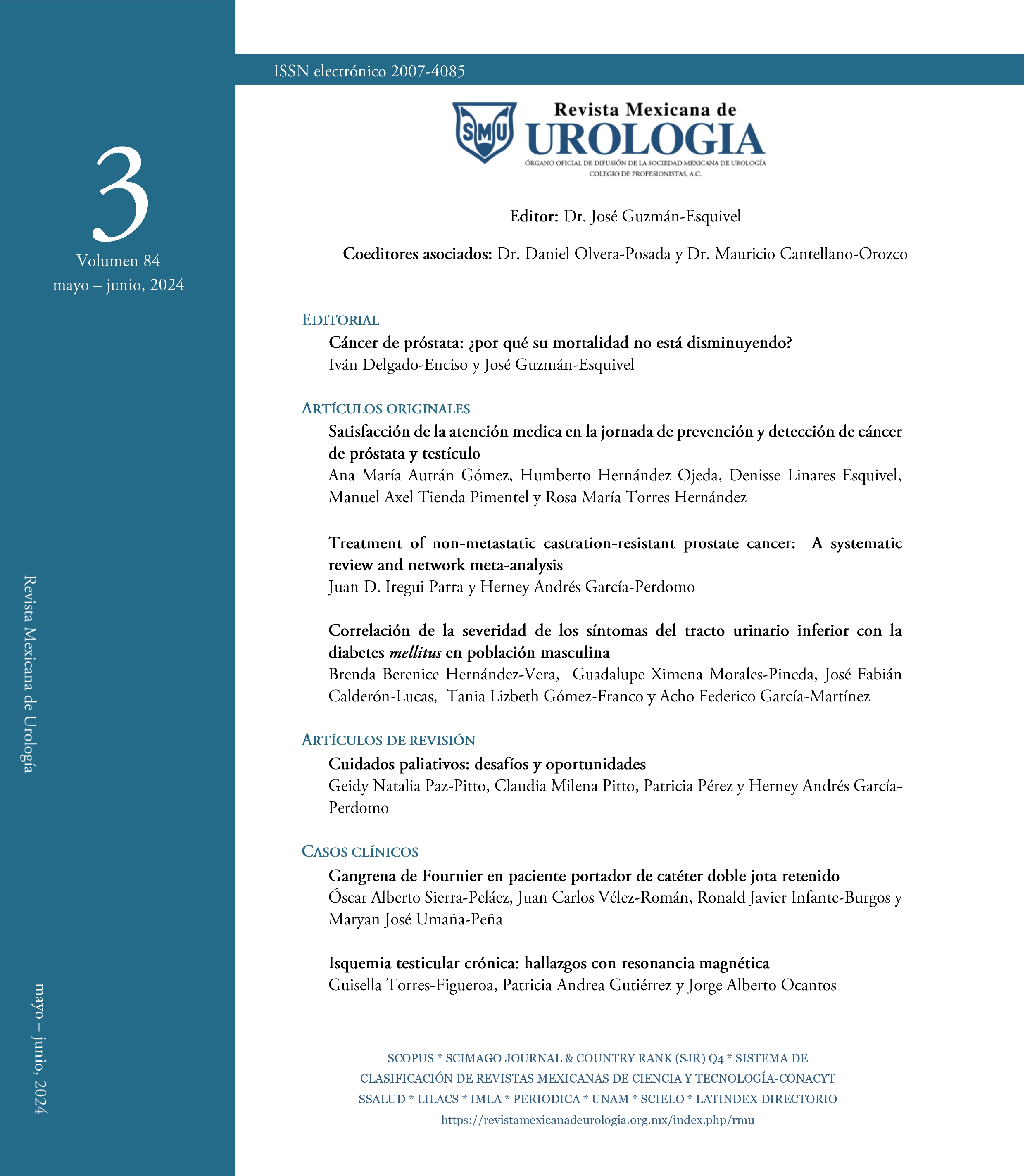Gangrena de Fournier en portador de catéter doble jota
DOI:
https://doi.org/10.48193/fw37vf52Keywords:
Fournier's gangrene, Necrotizing fasciitis, Double J catheterAbstract
Case report: A 30-year-old male patient, with a history of endoscopic ureterolithotomy plus placement of a double J catheter for 5 years. The clinical examination showed edema, redness, and heat that extended to the base and shaft of his penis. Laboratory tests, soft tissue ultrasound and Urotac were performed, showing a 30-cc collection at the base of the penis with debris inside, and gas area in the soft tissues in front of the pubic area and at the base of the penis. Surgery was performed with the intention of draining the abscess and taking a sample for culture, testing positive for Escherichia coli. The diagnosis was Fournier's gangrene. In-hospital management was performed, including broad spectrum coverage with Piperacillin / Tazobactam.
Relevance: Fournier's gangrene is a progressive necrotizing, soft tissues infection, affecting the external genitals and/or perineum. It generally occurs in older men and is considered a urological emergency due to its rapid progression and high lethality; even under the administration of broad-spectrum antibiotics and extensive surgical debridement, it could be fatal. Among its predisposing factors are diabetes mellitus, kidney failure, obesity, alcoholism, hallucinogens, steroids, smoking, cancers, and HIV.
Clinical implications: Main implications of this case are related to a better control, and surveillance to patients with double J catheter. It is recommended the removal of these devices within the appropriate period of time, in order to decrease the risk of complications such as Fournier’s gangrene due to its inadequate utilization.
Conclusion: Fournier's gangrene could be associated with the use of double J catheter, which is a medical device frequently used in the urology area. Therefore, this device should be removed from all patients at the indicated times, reducing the probability of suffering from this infection.
References
Syllaios A, Davakis S, Karydakis L, Vailas M, Garmpis N, Mpaili E, et al. Treatment of Fournier’s Gangrene With Vacuum-assisted Closure Therapy as Enhanced Recovery Treatment Modality. In Vivo (Athens, Greece). 2020;34(3): 1499–1502. https://doi.org/10.21873/invivo.11936.
Heyns CF, Theron PD. Fournier’s Gangrene. In: Hohenfellner M, Santucci RA (eds.) Emergencies in Urology. Berlin, Heidelberg: Springer; 2007. p. 50–60. https://doi.org/10.1007/978-3-540-48605-3_6. [Accessed 4th June 2024].
Wróblewska M, Kuzaka B, Borkowski T, Kuzaka P, Kawecki D, Radziszewski P. Fournier’s gangrene--current concepts. Polish Journal of Microbiology. 2014;63(3): 267–273.
Auerbach J, Bornstein K, Ramzy M, Cabrera J, Montrief T, Long B. Fournier Gangrene in the Emergency Department: Diagnostic Dilemmas, Treatments and Current Perspectives. Open Access Emergency Medicine. 2020;12: 353–364. https://doi.org/10.2147/OAEM.S238699.
Ngugi P, Magoha G, Nyaga P. Fournier’s ganrene in the HIV era. African Health Sciences. 2014;14(4): 1063–1068. https://doi.org/10.4314/ahs.v14i4.38.
Zingaro MD, Boni A, Vermandois JARD, Paladini A, Lepri E, Ursi P, et al. Fournier’s Gangrene and Intravenous Drug Abuse: an Unusual Case Report and Review of The Literature. Open Medicine (Warsaw, Poland). 2019;14: 694–710. https://doi.org/10.1515/med-2019-0114.
Jiwrajka M, Pratap K, Yaxley W, Dunglison N. Result of Health Illiteracy and Cultural Stigma: Fournier’s Gangrene, a Urological Emergency. BMJ case reports. 2017;2017: bcr2017220836, bcr-2017–220836. https://doi.org/10.1136/bcr-2017-220836.
Hagedorn JC, Wessells H. A contemporary update on Fournier’s gangrene. Nature Reviews Urology. 2017;14(4): 205–214. https://doi.org/10.1038/nrurol.2016.243.
Radcliffe RS, Khan MA. Mortality associated with Fournier’s gangrene remains unchanged over 25 years. BJU international. 2020;125(4): 610–616. https://doi.org/10.1111/bju.14998.
Tang LM, Su YJ, Lai YC. The evaluation of microbiology and prognosis of fournier’s gangrene in past five years. SpringerPlus. 2015;4(1): 14. https://doi.org/10.1186/s40064-014-0783-8.
Castillejo Becerra CM, Jaeger CD, Rose JR, Beecroft NJ, Shah NC, Posid T, et al. Microorganisms and Antibiogram Patterns in Fournier’s Gangrene: Contemporary Experience from a Single Tertiary Care Center. The Journal of Urology. 2020;204(6): 1249–1255. https://doi.org/10.1097/ju.0000000000001194.
Perkins TA, Bieniek JM, Sumfest JM. Solitary Candida albicans Infection Causing Fournier Gangrene and Review of Fungal Etiologies. Reviews in Urology. 2014;16(2): 95–98.
Downloads
Published
Issue
Section
License
Copyright (c) 2024 Revista Mexicana de Urología

This work is licensed under a Creative Commons Attribution-NonCommercial-NoDerivatives 4.0 International License.






